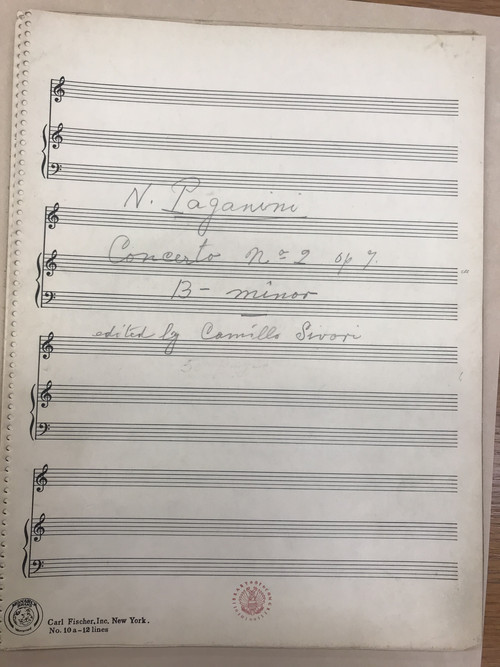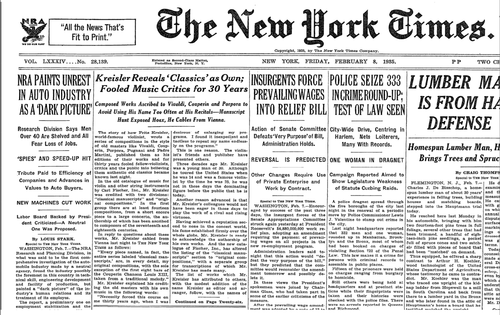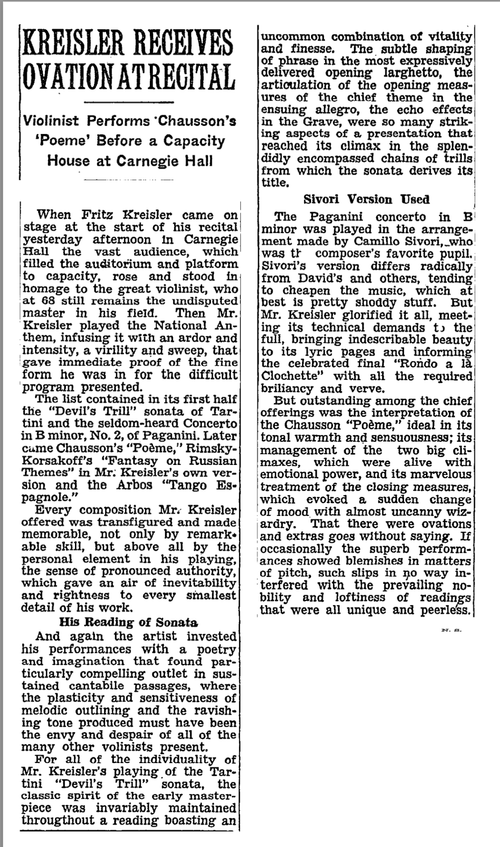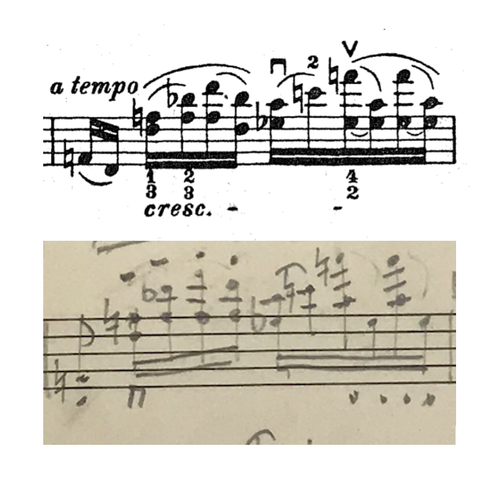Kreisleriana: Fritz Kreisler Rediscovered, Part 4: Paganini's 'La Campanella'
While going through Fritz Kreisler's papers at the Library of Congress I found something that surprised me: an unpublished Paganini arrangement by Kreisler, something he had apparently performed but never recorded.

Cover from Kreisler's complete manuscript of Paganini's Violin Concerto No. 2.
I knew when I saw it that I wanted to play this piece as the conclusion to my recital program of works relating to Kreisler - which has been the inspiration for this series of articles. Here I'd like to delve into how Niccolò Paganini - ultimate showman - inspired a number of arrangements by Kreisler.

Two violinists a century+ apart: Fritz Kreisler in 1944; Niccolò Paganini in an 1831 illustration by Richard James Lane.
Kreisler arranged several pieces by Paganini as early as 1905, then some Caprices in 1913, and the Violin Concerto No. 1 in 1937. Why exactly would Kreisler want to arrange pieces that were already originally written for violin?
In the case of the Caprices, Kreisler was providing accompaniment for music that was originally written as unaccompanied. But for the rest, one must realize that original Paganini pieces had only sparse accompaniments, and orchestras were forced to sight-read at rehearsal and then return parts. Paganini jealously guarded his secrets; he didn’t practice in front of anyone and nobody ever saw his music. This couldn’t have made for great rapport and cohesion! It also meant that when it came to "original" accompaniments by Paganini - there was oftentimes little to go on.
It's similar to what we find in Baroque music - when we perform sonatas of the Baroque composers we are quite often unknowingly playing realizations of parts that were figured bass. It was understood by musicians of the time that they should be creating a part with this notation and quite often it was different from performance to performance.
Kreisler made an arrangement of the Paganini's Violin Concerto No. 1 in 1936, and this is the only piece by Paganini that Kreisler ever recorded:
There is no mistaking it for its Viennese-tinged treatment of the material - this is certainly Kreisler. This was from an age when typically only the first movement - in arrangements by the German violinist August Wilhelmj - was performed.
One of Paganini’s most popular pieces was his Concerto No. 2, whose third movement is "La Campanella," or "The Bell" - a movement that became something of a breakout hit.
The novelty of the bell in the third movement is what caught the public's imagination. Paganini created a stir wherever he went; he helped set music on a romantic path influencing Franz Schubert, Robert Schumann and most importantly, Franz Liszt.
Liszt was 20 when he first heard Paganini perform in Paris. He was a fully formed artist, but Paganini's musicianship and showmanship convinced Liszt to redouble his efforts and model himself in the Paganini vein. Liszt even made a set of etudes based on several of Paganini Caprices and on "La Campanella." Liszt had worked at it over the years till reaching the final version we all know today.
Whereas other pianists may wish to highlight their technical prowess, Ginsburg's singing and musical qualities bring out the operatic nature of Paganini's original themes.
These days Paganini’s fame has been reignited for a 21st-century general public - I realized this a couple of years ago when my niece surprised me by asking if she could learn "La Campanella." I had been behind the times - "La Campanella" had come to K-pop! Here it is, Blackpink's "Shut Down":
Certainly the Korean music industry knows how to make a good product and they know a catchy tune when they hear it!
Kreisler’s 1905 arrangement of "La Campanella" takes out the lyrical section and thereby eliminates the rondo form. It is still very effective and quite popular in recital today.
"Sivori" Edition?
While searching through Kreisler's papers at the Library of Congress, I found an unpublished arrangement of Paganini’s complete Violin Concerto No. 2. This arrangement - clearly written in Kreisler's handwriting - features all three movements and a new accompaniment. But it is described on the title page as "edited by Camillo Sivori."
First, who was Camillo Sivori? He was Paganini’s only recognized student. He had worked with Paganini - who by Sivori’s account was a horrible teacher! Paganini described him as "the only one who may call himself my pupil." In the second half of the 19th century, Sivori toured extensively, even making it to North and South America. He was acclaimed for not only his virtuoso technique but also his musicality and musicianship. He gave the British premier of Mendelssohn’s Violin Concerto in E minor. His own compositions have not stayed in the repertoire but show a violinist with technique to burn.
But wait - was this an edition by Sivori - or was it one of Kreisler's famous hoax editions? In 1935, Kreisler admitted to the hoax of being the author of pieces he had claimed were long-lost works by old masters. It was front-page news in the New York Times.

New York Times hoax article from 1935.
He didn’t get any backlash for this - he was still just as beloved. So why, eight years later in 1943, would he claim that this version of Paganini Concerto 2 was by Sivori?

New York Times article from 1943.
Putting Sivori’s name on the page would surely legitimize the edition, but the New York Times critic was still pretty brutal: "Sivori's version differs radically from David's and others, tending to cheapen the music, which at best is pretty shoddy stuff," the review reads. Perhaps Kreisler felt uncomfortable with the idea of this edition and wanted to let someone bear the responsibility of having made changes. Of course the reviewer still loved Kreisler, going on in the very same review: "...But Mr. Kreisler glorified it all, meeting its technical demands to the full, bringing indescribable beauty to its lyric pages..." etc.
So was there ever a Sivori edition of "La Campanella?" Sort of... Hugo Hermann, in his memoirs, tells an interesting story regarding a competition that took place in Cirque Napoléon in Paris, between the French violinist Jean-Delphin Alard and Sivori.
"When Sivori sounded the first notes of Paganini’s second concerto, which I knew very well from the printed editions, Sivori’s rendering departed very drastically from this. In fact, it was scarcely recognizable. In the last movement [the Bell Rondo] he even introduced a theme from a Spohr string quartet, which was very cleverly interwoven with the typical Paganini wizardry. I was naturally very interested and as soon as I had an opportunity, I questioned Sivori about it and asked his permission to copy out his version, which increased the work’s effectiveness to a sensational degree. However, he told me that he had learned this version directly from Paganini without one single note having ever been written down. Evidently, Sivori wished to guard the secret for himself!” (from Paganini the Genoese.)
That being said, this is not that edition. In the edition that I found among Kreisler's papers, there is no straying from the original source material except for the introduction, which bridges the slow movement into the third-movement "La Campanella." Also, the large orchestral tutti in the middle of the last movement is cut short and there is a new coda which is similar to Kreisler’s earlier effort.
The introduction is about a minute and a half. Kreisler uses the piano to foreshadow the bells, in this case a darker deeper version of them. In the bass, you get repeated notes that sound like gonging of large church bells .
The original form of "La Campanella" is a rondo in A-B-A-C-A form - this is retained, unlike in Kreisler's earlier effort. This time, Kreisler retains lyrical section C and changes the register to an octave lower and retains the artificial harmonics in the original octave.
When I was a younger more nimble violinist, I did play the original version. But I never felt that good about the ninths and thought they were a little awkward for my hands. Apparently so did Kreisler:

It made my life a lot easier, and I’m sure most people listening might not even notice the subtle change. Remember that in 1943, Kreisler was in his late 60s, so this would have been an incredible piece to end a recital with.
The piece ends with a new coda, which might a little TOO long, but is indeed effective.
Kreisler must have spent a ton of time working on this. He obviously performed it a lot, as the piano part is well worn. Additionally he wrote a full orchestration - obviously in the hopes of performing it with orchestra.
So I present to you, for the first time, the 1943 version of Kreisler’s "La Campanella," played by me and pianist Michelle Kim:
I must thank the wonderful people at the Library of Congress, who spent days sifting through boxes of Kreisler's papers with me. But it cannot be emphasized enough, how much time pianist Michelle Kim spent working with me on this project. If not for her, this recital would not have been half as much fun, or half as successful. Her ability to tell me I still had something to say and talent in bringing it out of me is the definition of a true collaborative artist.
* By the way, a few people asked me where I got the Ferrari-style Paganini T-shirt that I'm wearing in this performance - here is the link!
You might also like:
- Kreisleriana: Fritz Kreisler Rediscovered, Part 1
- Kreisleriana: Fritz Kreisler Rediscovered, Part 2: Bach Mozart and Beethoven Reductions
- Kreisleriana: Fritz Kreisler Rediscovered, Part 3: Rachmaninoff and Korngold arrangements
* * *
Enjoying Violinist.com? Click here to sign up for our free, bi-weekly email newsletter. And if you've already signed up, please invite your friends! Thank you.
Replies
That's a great observation Jean!
Again, thank you to Darwin and Michelle. I hope in due course to hear and read more from you. What future projects are planned?
This article has been archived and is no longer accepting comments.
Violinist.com is made possible by...
Dimitri Musafia, Master Maker of Violin and Viola Cases
International Violin Competition of Indianapolis
Violinist.com Holiday Gift Guide
Johnson String Instrument/Carriage House Violins
Subscribe
Laurie's Books
Discover the best of Violinist.com in these collections of editor Laurie Niles' exclusive interviews.

Violinist.com Interviews Volume 1, with introduction by Hilary Hahn

Violinist.com Interviews Volume 2, with introduction by Rachel Barton Pine








September 2, 2025 at 04:27 PM · That recording by Kreisler of Paganini 1 is interesting in that the virtuosic passages are so sloppy, even just plainly out of tune, by modern standards at least. If a contestant would play like that in a competition nowadays, they would be sent back home tarred and feathered!